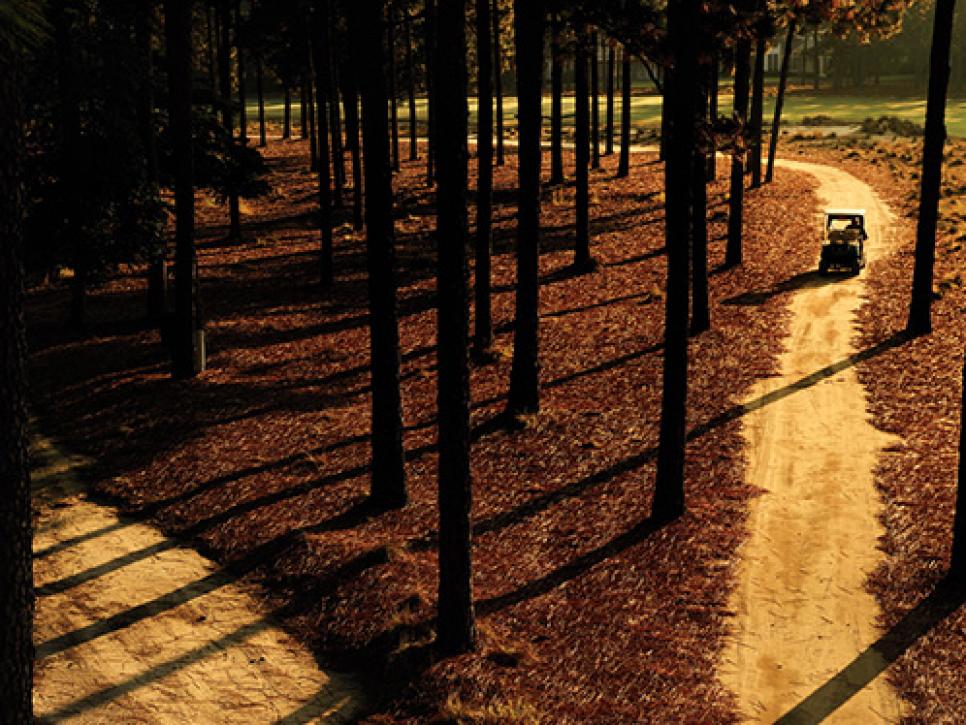News
Back-to-Back Backbreaker?

Pinehurst No. 2's restoration shows the par-4 seventh, which will be 424 yards for the men and 389 for the women.
This year, the United States Golf Association's cash cow becomes its beast of burden. Not only will Pinehurst No. 2 be the host of the U.S. Open on June 12-15 and the U.S. Women's Open the next week, but the USGA has also foisted upon the course so many other roles, messages and object lessons as to turn Pinehurst into a pachyderm. The USGA is trumpeting Pinehurst's austere irrigation as something to consider, its absence of rough as something to behold and its minimally maintained bunkers as something to embrace. All that and double duty is a lot to ask.
The legendary course in the charming Village of Pinehurst, N.C., constructed, rebuilt and refined by legendary golf architect Donald Ross, who lived left of its third green for decades until his death in 1948, is thrust into a fortnight as the all-purpose, do-everything answer to golf's woes:
It's strong enough for a man, yet not overpowering to a woman. It's a championship test that a resort duffer can play. It's a window to the past and the wave of the future. It's luxurious and a money-saver. It's a floor wax and a dessert topping.
I've been a longtime supporter of the USGA and a defender of many of its most controversial decisions, including its upcoming ban on anchored putting. I'm an enthusiastic fan of the way its executive director, Mike Davis, has set up courses for championships. So it pains me to take issue with any decision of the USGA. But its tandem U.S. Opens is tantamount to tokenism. With the men playing first, it smacks of banquet leftovers for the women, trickle-down largesse.
I have no quarrel with the course. Pinehurst No. 2 is a fabulous layout, ranked 40th among Golf Digest's latest list of America's 100 Greatest Golf Courses
and frankly deserving of an even better spot after a 2010 restoration by Bill Coore and Ben Crenshaw and their team. They removed all the Bermuda rough that had been foolishly installed in the 1970s and re-established areas of hardpan sand, dotting them with tufts of wiregrass to allow the native vegetation to become established.
This will be the first U.S. Open and Women's Open in memory without narrow fairways framed by deep grass. (At Pinehurst in 1999 and 2005, the men faced sticky Bermuda rough of three inches.) Many of No. 2's fairways are now extremely wide, 45 yards or more, which allows players to position drives to provide the optimum angle of approach into greens. A few shorter par 4s still have fairways pinched into landing areas to provide the reward of a shorter approach shot for the risk of a long, accurate drive. But the penalty for a bad tee shot won't be a lie in ankle-deep gunch. It'll be a lie that can be easily found but not easily played.
"I hope we see some balls on hardpan," Davis says, "some balls in softer sand with footprints, some up against a patch of wiregrass, some that are sitting on pine needles. We want to see all that."
Coore calls the vast sandy areas "the stuff."
"When they hit into the stuff and have to play out of it," he says, "we're going to see some of the craziest shots coming from some of the most talented players in the world."
Combine that with Pinehurst's famous perched putting surfaces, greens that look big but play small because of sloping edges, and the result is a test of golf that demands creativity as much as caution. It ought to make for a great U.S. Open. And a great U.S. Women's Open.
I just don't like them back-to-back. The men will be getting pristine conditions; the women get the stadium the day after the Super Bowl. Tournament conditions routinely stress a golf course over a week, let alone two weeks in a row. Then there's the havoc that weather delays might cause, spilling from one championship to the next.
Former Women's Open champion Cristie Kerr tells us she won't be able to get into her housing at Pinehurst until Monday night of the second week. "What happens if there are weather delays?" Kerr asks. If the final round ends up on Monday, forcing an 18-hole playoff to Tuesday, "that means the girls can't get on the course until Wednesday!" Kerr says.
Davis met with the LPGA players in March to hear their concerns and ease them. "We could have a playoff on Tuesday," he told me before that meeting. "We'll still let the women play practice rounds. We could have the women on other holes during a playoff." Under one scenario for a Monday playoff, play would begin at noon, and LPGA players would be allowed on the course beginning at 7 a.m and then again after the playoff. "Remember," Davis says, "it rained so much at the Open last year at Merion that some men got to practice only 27 holes."
Stacy Lewis points out that the Women's Open doesn't have a next-day 18-hole playoff. It's settled by a three-hole playoff immediately after the final round. "I would have preferred the women went first," she says. "The men would not have the risk of losing a day as a result of a playoff."
THE MONEY ANGLE
It has always struck me that back-to-back Opens is convenient mainly to the USGA and its pocketbook.
"Contrary to what many think, this is not a way to save money," Davis says.
That might be the position today, with the USGA holding its billion-dollar television contract with FOX, but when the back-to-back Opens were announced in 2009—when the economy was tanking and even the USGA was dismissing employees—then-executive director David Fay candidly admitted there were "economies of scale" in the package, avoiding duplication of expenses for such things as vendors, bleachers, hospitality tents, portable toilets and the like. (Fay says he had a bigger problem at the time: finding a suitable venue for the Women's Open, as he explains on page 166) Still, he professed an altruistic motive for his invention.
"This is being done primarily to elevate the Women's Open," Fay told me in 2009. In other words, the Women's Open has traditionally been a loss-leader, not a money-maker. But it worked. The USGA reports it sold about 10,000 packages containing two-week passes to both Opens. Including corporate attendees, media, vendors and spectators, daily attendance is predicted at 55,000 for the men and 25,000 for the women. And having the Women's Open in the same conversation with the men's championship has already raised the profile with articles like this one.
Fay said he got the idea from the men's and women's U.S. Opens of professional tennis, conducted concurrently, not consecutively. During Fay's tenure, the USGA conducted some concurrent events at multiple courses, including the U.S. Boys and Girls' Juniors and the U.S. Men's and Women's Public Links.
Why not play both Opens during the same week at Pinehurst? Both couldn't be played at the same time on Pinehurst No. 2 (not in four days, anyway), but there are plenty of other courses at the resort. Plus, there's a three-time Women's Open host, Pine Needles, just five miles away. Logistically impossible for television purposes, I've been told. Really? Coverage of golf on television is all about switching back and forth from hole to hole. Why not back and forth from course to course? The most plausible reason: The men's Open pays a lot of bills at the USGA, and you don't mess with the franchise.
There's an even more radical suggestion by former Women's Open champ Paula Creamer, who enthusiastically supports her national championship on Pinehurst No. 2: Have everyone play the same course, she says, with alternating tee times once the cuts have been made. Imagine crowning the women's and men's winners within 15 minutes of each other on the same green. The main arguments against: It would take four days just for the first 36 holes, and there'd be a huge field after the two cuts that could push the closing holes into darkness.

HOW THE SETUPS WILL BE THE SAME,
AND HOW THEY'LL DIFFER
'We have two intentions with back-to-back Opens," Davis says. "One is to compare the men and the women on the same golf course, set up the same way, relatively speaking. The other thing is to showcase women's golf."
Davis uses the phrase "relatively speaking" because the women won't be playing from the same tees as the men. The official yardage for the U.S. Open will be 7,565 yards, par 70. For the Women's Open, the course is listed at 6,649 yards, par 70. That's 87.9 percent of the men's yardage. One change from the 1999 and 2005 Opens: The famed par-4 fifth hole becomes a par 5, and the par-5 fourth hole becomes a par 4. New forward tees on Nos. 3 and 13 will give Davis the option of tempting players with drivable par 4s.
"Women professionals never get enough credit for how truly good they are," Davis says. "They do play a slightly different game. They hit the ball a little straighter than men. They don't hit it quite as far or as high—most of them, anyway. And they don't spin it quite as much. But they play a wonderful game, and this has the ability to showcase that. On a given hole, if the men are hitting driver, we want to see the women hit driver. If the men are hitting 8-iron into a green, that's what we want to see the women do. If you just look at the average drives from each tour, there's about 40 yards' difference off the tee between men and women."
So the tee-shot landing zones are mostly 40 yards apart (and 40 yards long) with the women's zones closer to the greens. This should alleviate concerns, Davis says, that the women will be hitting onto fairways pockmarked with the men's divots. That worry is overblown, he says. They'll be hitting well past those areas. It won't be a problem.
Except maybe on the par 5s. As Creamer points out, men and women tend to lay up in the same vicinity, about 100 yards out. "Divots in those areas could be an issue during the second week because it can't be adjusted by tee-box setup," she says.
NATURE AND THE GREENS
Also consider Pinehurst's bentgrass putting surfaces. The plan is to have them running at 11.5 feet on a Stimpmeter for both events, and if the weather cooperates, the greens should be only "slightly softer" during the second week, Davis says. The greens, many of which are shaped like giant mushrooms, don't have many pin placements. So few that some holes won't be changed during practice rounds. So few, in fact, that last fall there was talk about using the same hole locations for the Women's Open that will be used in the men's. Davis has since backed off from that plan a bit.
"I think we'll go with the same quadrants," he says. "The idea is, if on the first hole we're back-left on Saturday for the men, we'll be back-left on Saturday for the women as well. But will we use the same exact hole? As much as I'd love to do that, once you set the hole plug back in, particularly with drier greens, it shrinks a little. So you might see a hole that's 26 paces back and five left for the men, and for the women it's 25 paces back and six left. They'll be a pace to a pace-and-a-half apart from one another. That's the goal."
The old standard in agronomy is that it takes a cup plug three weeks to fully heal, and that's assuming normal irrigation practices. During the Open, the greens will get little if any water, unless it rains. So expect to see some women putting over visible plugs from the men's Open. I can't imagine, if the roles were reversed, any of the men would be happy about that situation. These are guys who complain if a player walks beyond the cup and steps on their "through-line."
Traditionally on a late Sunday afternoon of any U.S. Open, the greens are stressed to the maximum, at times so dry and parched as to be near death. What happens if those greens die on Sunday night? Davis insists there's little chance of that because the greens won't be mowed that short to begin with. "Pure and simple, the success of both Opens has everything to do with the greens," Davis says. "If we're lucky enough with Mother Nature, we can dry out the greens for week one so we'll get that bounce-bounce-stop to approach shots. When we get done Sunday night, we'll give them a nice drink of water, and by the time we get to Tuesday, they'll be starting to dry out again. Our ability to get them like that for both Opens is much better going in this order. It's easier to add a bit of water than to remove it."
I asked Davis why it's important to compare men and women golfers. "Because it just hasn't been done before," he says. "People have stereotypes. People have misconceptions. This is a pretty neat opportunity to let men and women perform at the same time at the same place."
Actually, it has been done before, sort of. Oakmont was host of the U.S. Open in 2007 and the U.S. Women's Open in 2010. Angel Cabrera won the men's Open, shooting five over par on the 7,230-yard, par-70 layout. Creamer shot three under par on a 6,613-yard, par-71 Oakmont to win the Women's Open by four. No one has since claimed the women outplayed the men on one of golf's toughest layouts, even though Oakmont's greens were running at 14.5 on the Stimpmeter for both events and Davis set up the Women's Open to require them to hit the same types of shots into greens that the men had hit. But the rough was lower for the women, and rain softened the putting surfaces.
Davis admits weather conditions could change drastically during the two-week window at Pinehurst and spoil his plans.
"I remember at the '99 Open, we had such cool weather that guys wore sweaters. We could have that one week, and the next week it might be hot and humid with thunderstorms. So all our preparation has been just an exercise on paper. If Mother Nature won't allow us to play one week the same as the next, that's OK. That's golf. It's an outdoor sport."

NEW MESSAGE ON TURF, BUNKERS
Davis is equally excited that Pinehurst No. 2 will be a showcase for radically different maintenance practices. Coore and Crenshaw removed 40 acres of turf and more than 700 irrigation heads. Bob Farren, Pinehurst's director of golf-course and grounds management, estimates he's using 60 percent less water. It meshes with the USGA's initiative of encouraging "Maintenance Up the Middle," which urges focus on tees, fairways, greens and green surrounds but limiting resources everywhere else.
"You just hope, around the world, people will look at this golf course and say, 'Golf doesn't have to be lush and green,' " Davis says. "It's a throwback to the old days. Spend less time and money on irrigation, fertilizer and fungicides in the rough."
Davis acknowledges that No. 2's sandy wiregrass areas are not maintenance-free. In fact, Farren says the maintenance that is needed to control the many weeds that pop up in the sandy grass requires different techniques, including removing them by hand.
Before the restoration, Pinehurst No. 2 had six heights of grass. Now it has only two: the greens and everything else. Except for the Opens, when it will have three. Davis is raising the cut of fairways a bit to slow down the run of the ball. The green surrounds (Pinehurst's famous chipping areas) will be a higher cut than the greens but slightly lower than the fairways, tight enough to putt on but not so tight as to discourage pitch or chip shots.
Davis and the USGA are also high on the fact that Pinehurst spends so little time and money on bunker maintenance. The natural sandy hardpan areas aren't raked at all. Those areas are played not as hazards but "through the green," so the clubface may be grounded when addressing the ball. No relief from footprints, though.
The formal bunkers have packed sides, and only their flat bottoms are routinely raked. In some spots, where a natural area bleeds into a bunker, it's hard to determine if a ball is in the bunker or not.
A year ago, Davis said the rule of thumb during both Opens would be, "If there are rake marks beneath the ball, treat it as a bunker. Otherwise, it's through the green." But with many bunker faces and corners not raked, he has abandoned that plan.
"If there's a depression, even if it's unraked, it's still a bunker," he says. "Besides, we're going to have a walking official with every group. That person ultimately can make the call if the player can't."
That will probably work in the Opens, assuming the officials are proactive, unlike what happened to Dustin Johnson in the 2010 PGA Championship at Whistling Straits. But what about the everyday resort golfer at Pinehurst No. 2 who doesn't have the luxury of a rules official? Shouldn't the USGA be promoting simpler rules if it wants everyone to play within them?
That's the problem with this year's back-to-back U.S. Opens. It's turned Pinehurst into a pulpit, and the messages are mixed. Two heights of grass are good enough, except when they're not. Cutting irrigation saves money, except when it doesn't. Women can play the same course as men, relatively speaking.
The most egregious message of all? Well, the world's best men will be playing for an $8 million purse in this year's U.S. Open. The world's best women will be playing for a $3.25 million purse the next week. They'll be playing 88 percent of the same course for 41 percent of the money.
If the USGA really wants to elevate women's golf, and its national women's championship, it ought to be compensating the women more in kind.


